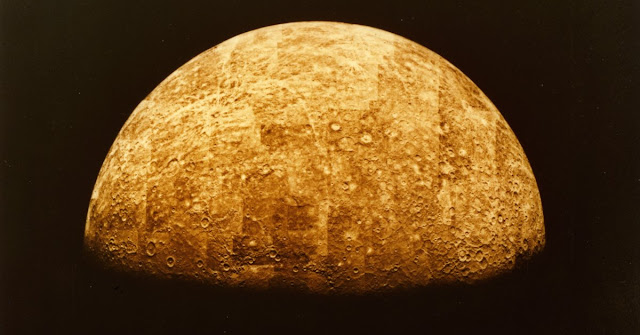MERCURY
BLACK HOLE | MERCURY | SOLAR SYSTEM | PLANET | GALAXY | STARS | UNIVERSE | COSMOLOGY | ASTROPHYSICS | COSMOS
Mercury, the innermost planet, is never easy to study from Earth. It is small, with a diameter of only 4878 kilometres (3030 miles); it always stays in the same region of the sky as the Sun, and it never comes much within 80 million kilometres (50 million miles) of us.
Moreover, when it is at its nearest it is new, and cannot be seen at all except during the rare transits. Mercury has a low escape velocity, and it has always been clear that it can have little in the way of atmosphere. The orbital period is 88 days.
It was once assumed that this was also the length of the axial rotation period, in which case Mercury would always keep the same face turned towards the Sun, just as the Moon does with respect to the Earth; there would be an area of permanent day, a region of everlasting night, and a narrow ‘twilight zone’ in between, over which the Sun would bob up and down over the horizon – because the orbit of Mercury is decidedly eccentric, and there would be marked libration effects.
However, this has been shown to be wrong. The real rotation period is 58.6 days, or two-thirds of a Mercurian year, and this leads to a very curious calendar indeed. To an observer on the planet’s surface, the interval between sunrise and sunset would be 88 Earth-days.
The orbital eccentricity makes matters even stranger, because the heat received at perihelion is 21 ⁄2 times greater than at aphelion. At a ‘hot pole’, where the Sun is overhead at perihelion, the temperature rises to 127 degrees C, but at night a thermometer would register 183 degrees C.
Mercury has an extremely uncomfortable climate. To an observer situated at a hot pole, the Sun will rise when Mercury is at aphelion, and the solar disk will be at its smallest.
As the Sun nears the zenith, it will grow in size, but for a while the orbital angular velocity will be greater than the constant spin angular velocity; our observer will see the Sun pass the zenith, stop, and move backwards in the sky for eight Earth-days before resuming its original direction of motion.
There are two hot poles, one or the other of which will always receive the full blast of solar radiation when Mercury is at perihelion. An observer 90 degrees away will have a different experience; the Sun will rise at perihelion, so that after first coming into view it will sink again before starting its climb to the zenith.
At sunset it will disappear, and then rise again briefly before finally departing, not to rise again for another 88 Earth-days. Mercury has a globe which is denser than that of any other planet apart from the Earth.
There seems to be an iron-rich core about 3600 kilometres (2250 miles) in diameter (larger than the whole of the Moon), containing about 80 per cent of the total mass; by weight Mercury is 70 per cent iron and only 30 per cent rocky material.
The core is presumably molten, and above it comes a 600-kilometre (370-mile) mantle and crust composed of silicates. Most of our detailed knowledge of Mercury has been obtained from one probe, Mariner 10.
It was launched on 3 November 1973, and after by-passing the Moon made rendezvous with Venus on 5 February 1974. The gravity field of Venus was used to send Mariner in towards an encounter with Mercury, and altogether there were three active passes before contact was lost: on 29 March and 21 September 1974, and 16 March 1975, by which time the equipment was starting to fail.
The last messages were received on 24 March 1975, though no doubt Mariner is still orbiting the Sun and still making periodical approaches to Mercury. As expected, the atmosphere proved to be almost nonexistent.
The ground pressure is about 1/10,000,000,000 of a millibar, and the main constituent is helium, presumably drawn from the solar wind. A magnetic field was detected, with a surface value about one per cent of the Earth’s field; there are two magnetic poles of opposite polarity, inclined by 11 degrees to the rotational axis.
The polarity of the field is the same as ours; that is to say, a compass needle would point north. The field is just strong enough to deflect the solar wind away from the planet’s surface.
It has to be admitted that Mercury is not a rewarding telescopic object, and little will be seen apart from the characteristic phase. Any form of life there seems to be totally out of the question.





Nice and new article.
ReplyDeleteWe learned something today
ReplyDeletegood job!